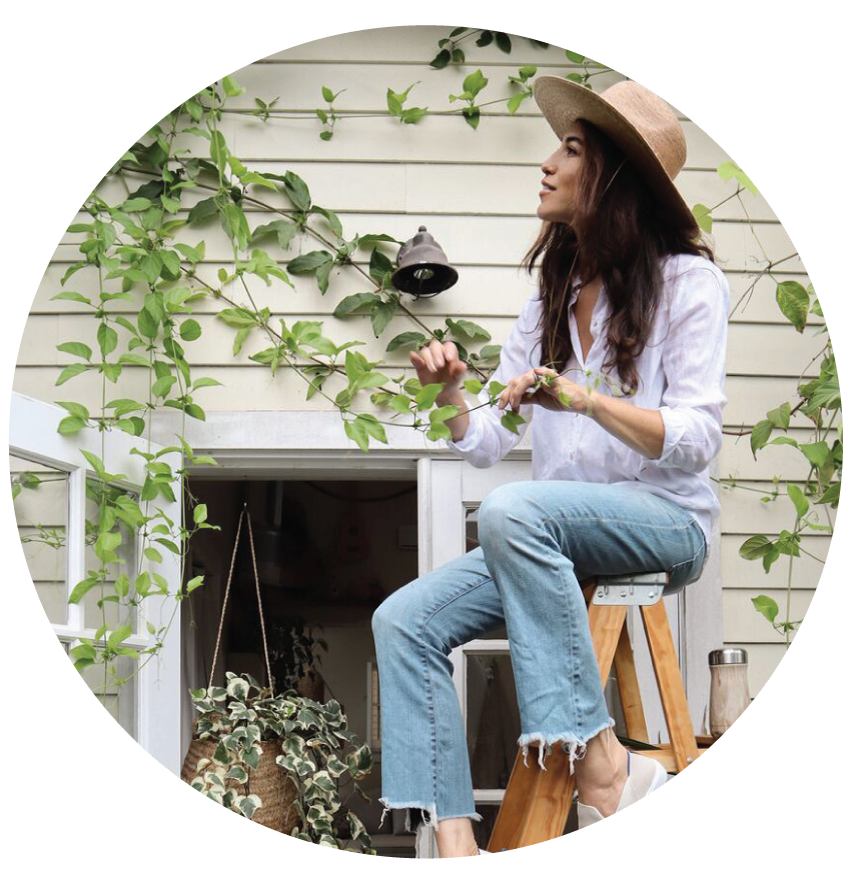Small Space Gardening to Manage Anxiety (and How to Donate Fresh Produce in Los Angeles)
Over the years, @adamwinkleman and I have been given hand-me-down items (like an inflatable splash pool, a bounce house, a playhouse, and a deep potting bench) that instantly became comically huge in the context of our small garden. We of course passed those items onward— they never would’ve fit, or fit in a way that would’ve allowed us to navigate around them, as our outdoor zones are all only about 8’ - 10’ wide without taking any landscaping or architectural accents into account.
When we were planning where to grow our vegetable garden, we first considered how our family, the pups, and/or the neighbors naturally use each area of the yard. Ultimately we decided that the best spot was our 8’ porch and the path leading up to it.
The reality of this slim porch is that every day it serves as a play area, a living/office space, a grow zone, a pathway, and a drying spot for laundry and kitchenwares.
We’re now about 3 months into our growing experiment and in its current state the porch is certainly not particularly stylish, and it’s always somewhat of a mess. But it is highly functional, well-used, much loved, and deeply appreciated.
I’ve shared the following quote twice before, but I’m doing so again because it was this particular passage that helped us picture how we’d transform the space pictured above into the space pictured below.
“Every vacant lot, every grimy unused alley, has been repurposed and turned into a shady grove. Every rooftop has been converted to either a vegetable or floral garden. Windowless buildings that were once scrawled with graffiti are instead carpeted with verdant vines… Things that used to be done individually are now done communally— growing vegetables, capturing rainwater, and composting… In community gardens, on rooftops, at schools, and even hanging from vertical gardens on balconies, food sometimes seems to be growing everywhere.” - The Future We Choose: Surviving the Climate Crisis
We opted to turn our storage benches (which we adapted into seating with the help of 2 custom outdoor seat cushions and 2 back cushions) into raised-bed planters. We simply removed the lids and lined the boxes for seasonal use as planters.
In addition to the box planters, we have two Lettuce Grow Farmstands, which enable us to grow up to 72 plants within about 4 sqft. We also have an array of hanging and potted edible plants.
Even though we’re typically home most of the time (as this is also our full-time office), Sheltering at Home has provided us with the unique opportunity to observe in detail how the garden has evolved over the past few months.
In our slim, city garden, we’re growing:
grapes
pumpkin
cherry tomatoes
tomatoes (3 varieties)
zucchini
broccoli
carrots
radishes
herbs
leafy greens / lettuces
sugar peas
red peppers
sweet peppers
jalapeño
cucumber
strawberries
watermelon
squash
But more than providing us with food, this is also providing us with a much-appreciated form of stress relief during this tumultuous time.
Above photo by Lucia Doynel
By putting down our phones, stepping into the sun, and working as a family (or solo) with our hands, Adam and I have noticed that we feel immensely better after gardening during periods of particularly heightened anxiety.
No matter how small this space is, having access to it — and the food it provides— is a privilege.
Green space is beneficial for community health, happiness and overall success. However, there is significantly less public green space in low-income and BIPOC communities.
In Los Angeles, access to natural commodities such as shade are an issue of equity and a marker of inequality— particularly in this era of climate crisis.
So is access to fresh food and produce.
One of the organizations working to address inequalities in access to fresh produce is SÜPRMARKT.
SÜPRMARKT is a low cost organic grocery servicing low income communities in LA. It operates weekly, providing 100% organic produce to make great health and healing available to the communities which need it most because everyone deserves healthy food.
- SÜPRMARKT
You can donate fresh produce to an individual, couple or family living in a local food desert by signing up as a one-time or repeat donor here.
SUAY also offers a way to donate farm boxes ($33) to those in need here in LA. They teamed with other like-minded businesses to create a CSA style food bank called “Know Your Grower, Know Your Sew-er.” Through this initiative and with their partners, they’re feeding over 200 garment worker families per week during the COVID crisis, as the average hourly wage of a garment worker in LA is $6, and the COVID crisis has crippled their already low income livelihoods.
We are deeply grateful for the opportunity to grow edible plants through therapeutic practices here at our tiny home. Through donations, informed voting and community activism, we aim to participate in remaking LA into a city where everyone has access to green spaces and green foods.



























